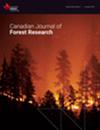早期移栽对英国天然更新红豆杉物理机械特性的影响
IF 1.7
3区 农林科学
Q2 FORESTRY
引用次数: 0
摘要
与重新种植相比,自然再生可以降低成本。然而,使用这种方法需要了解主动或被动管理将如何影响木材供应的质量和数量之间的平衡。本研究旨在量化呼吸法对体积恢复和木材特性的影响。使用不同间伐距离的西洋红豆杉和未间伐对照进行了两项英国森林实验,并在实施处理 21-22 年后进行了评估。对树木的尺寸进行了测量,并用于量化细长度、可销售体积和锯材体积。通过机械测试评估了子样本的木材特性。采用广义线性混合模型来检验处理和地点之间的差异。间伐降低了细长度,增加了相对锯材材积和树枝尺寸。较宽的间伐降低了木材强度,最宽的间伐降低了木材硬度。间伐对木材密度没有影响。然而,在这里考虑的生产力相对较低的地点,2.1 米的间伐是当前市场的最佳折衷方案。总之,不进行间伐可以改善木材的某些特性,但会降低树木的稳定性,减少锯材的比例和数量,从而对森林价值产生负面影响。本文章由计算机程序翻译,如有差异,请以英文原文为准。
Effects of early respacing on physico-mechanical properties of naturally regenerated Picea sitchensis in Great Britain
Natural regeneration can reduce costs compared with replanting. However, its use requires knowledge about how either active or passive management will affect the balance between quality and quantity in the timber supply. This study aimed to quantify the effects of respacing on volume recovery and wood properties. Two British forest experiments using Picea sitchensis with various respacing distances and an un-respaced control were assessed 21-22 years after the treatments were applied. Tree dimensions were measured and used to quantify slenderness, merchantable volume and sawlog-volume. Wood properties were assessed on a sub-sample using mechanical testing. Generalised linear mixed models were used to examine differences between treatments and sites. Respacing decreased slenderness and increased relative sawlog volume and branch size. Wider respacing reduced wood strength and the widest respacing reduced wood stiffness. Respacing did not affect wood density. However, at the relatively low productivity sites considered here, respacing to 2.1m represented the best compromise for current markets. In summary, not respacing improved some wood properties, but reduced tree stability and the proportion and volume of sawlogs, which will negatively affect forest value.
求助全文
通过发布文献求助,成功后即可免费获取论文全文。
去求助
来源期刊
CiteScore
4.20
自引率
9.10%
发文量
109
审稿时长
3 months
期刊介绍:
Published since 1971, the Canadian Journal of Forest Research is a monthly journal that features articles, reviews, notes and concept papers on a broad spectrum of forest sciences, including biometrics, conservation, disturbances, ecology, economics, entomology, genetics, hydrology, management, nutrient cycling, pathology, physiology, remote sensing, silviculture, social sciences, soils, stand dynamics, and wood science, all in relation to the understanding or management of ecosystem services. It also publishes special issues dedicated to a topic of current interest.

 求助内容:
求助内容: 应助结果提醒方式:
应助结果提醒方式:


